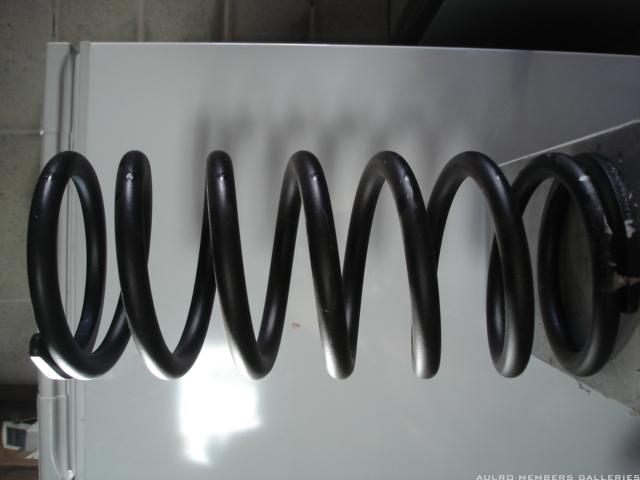-
3rd August 2006, 07:46 PM
#1
spring identification
with so much talk about suspension, is there any way of telling the spring rating from the measurements of the spring
when i brought my fender the seller threw in two brand new springs, he installed polyair instead and couldn't sell the spring
coil/rod diameter 19mm or 3/4in
height 415mm
6 and a bit coils
they are black and each spring has the following mark in white on the top
#13 and
#28
-
3rd August 2006, 07:54 PM
#2
you could try looking here, although your springs may have settled in height a little.
http://members.shaw.ca/jbarge/springinfo.html
-
4th August 2006, 07:07 PM
#3
For same material eg. steel (type of steel doesn't matter as modulus of rigidity does not change much):
Increasing wire diameter (d). increases spring rate. For reasonably small increases in wire diameter, the rate is proportional to d^4. ie. (d X d X d X d).
Say rover spring 1 is identical to rover spring 2 except wire dia of spring 1 is 17mm and wire dia of spring 2 is 19mm.
Then spring rate of spring 2 is spring rate of spring 1 X 19^4 / 17^4
ie. spring rate 1 X 1.56 or 56% stiffer.
Increasing number of active coils (n), reduces the spring rate. The spring rate is proportional to 1 / n.
Say rover spring 1 has 6 active coils and spring 2 has 8 active coils.
Then spring rate of spring 2 is spring rate of spring 1 X 6 / 8
ie. spring rate 1 X 0.75 or 75%
The difficulty of calculating an accurate spring rate for your unknown springs is to know the number of active coils.
Typically the coils at the ends are squashed together and the wire diameter is tapered to form a square seat for the spring (the terminology is squared and ground). These end coils are not active and it can be difficult to determine how many coils are active.
Spring rate is the load on the spring / the deflection of the spring. Usually given in lbs/inch or Newtons/mm.
So a 220 lb/in spring would need 220 lb to deflect it 1 inch.
-
4th August 2006, 08:05 PM
#4
the rules of thumb for the different spring ends are generally,
squared and ground -1.75 turns
plain ends -0.5 turns
plain ends ground -1.0 turns
this is usually pretty damn close for most calcs.
To add to what John has said, you add the total # of turns, then subtract 1.75 turns for your calc on Landy coils.
-
4th August 2006, 09:15 PM
#5
i don't think my brain can handle all those calculations, way to technical for me
i guess i will find out they sit if i ever fit them
phew
-
5th August 2006, 06:02 AM
#6
mate, give us an accurate wire diameter, ie. take it in a couple of spots, sans paint/powdercoat with an accurate vernier/dial caliper, the exact ID of the spring and an accurate (as close as you can tell) number of turns.
-
5th August 2006, 07:31 AM
#7
hey rick
with verniers
wire diameter 19.4 - 19.5mm
ID of spring 136mm with vernier
OD 74mm with tape measure
height 414mm
no of coils see below


 Posting Permissions
Posting Permissions
- You may not post new threads
- You may not post replies
- You may not post attachments
- You may not edit your posts
-
Forum Rules
Search AULRO.com ONLY!
|
Search All the Web!
|

Bookmarks